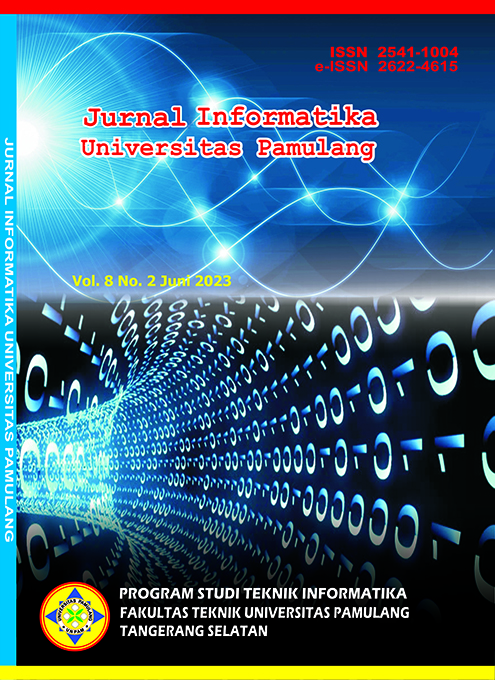Klasifikasi Sentimen Masyarakat di Twitter Terhadap Ganjar Pranowo dengan Metode Modified K-Nearest Neighbor
DOI:
https://doi.org/10.32493/informatika.v8i2.30686Keywords:
Ganjar Pranowo, Klasifikasi Sentimen, Modified K-Nearest Neighbor, TwitterAbstract
Dalam menyambut pesta demokrasi tahun 2024 banyak politisi mulai melakukan kampanye di setiap daerah yang menimbulkan banyak sentimen positif dan negatif yang berbeda pada setiap masyarakat Indonesia. Ganjar Pranowo merupakan salah satu politisi yang akan ikut andil sebagai bakal calon presiden 2024 yang membuat warganet di twitter banyak yang memberikan opini terhadapnya. Tujuan penelitian ini adalah untuk mengklasifikasikan sentimen masyarakat di Twitter terhadap Ganjar Pranowo dengan menggunakan 4000 data tweet. Klasifikasi dibedakan menjadi dua kelas yaitu positif dan negatif menggunakan metode Modified K-Nearest Neighbor yang dikombinasi dengan feature weighting, feature selection menggunakan teknik pendekatan supervised learning. Hasil dari penelitian ini setelah melewati tahap dari pengambilan, pelabelan data, preprocessing, feature weighting, feature selection, MK-NN dan evaluasi akurasi mendapatkan nilai akurasi tertinggi di 83,8% dengan perbandingan 90:10 dengan nilai k=3.
References
Fikry, M., Oktavia, L., & Dwi Arista, T. (2023). Klasifikasi Sentimen Masyarakat di Twitter terhadap Kenaikan Harga BBM dengan Metode K-NN. JUKI : Jurnal Komputer dan Informatika, 5(1), 140–150.
Kurniawan, S., Gata, W., Ayu Puspitawati, D., Tabrani, M., & Kadinar, N. (2019). Perbandingan Metode Klasifikasi Analisis Sentimen Tokoh Politik pada Komentar Media Berita Online. JURNAL RESTI:Rekayas a Sistem dan T eknol ogi Informasi, 1(3), 176–183.
Mulyaputra, D. (2023). Klasifikasi Islamophobia Berdasarkan Komentar Youtube Menggunakan Metode Term Frequency – Inverse Document Frequency Dan Modified K-Nearest Neighbor. Skripsi, program studi teknik informatika, Universitas Islam Negeri Sultan Syarif Kasim Riau.
Nur Royyan, A., Indriati, & Muflikhah, L. (2018). Analisis Sentimen Review Aplikasi Mobile Dengan Menggunakan Metode Modified K Nearest Neighbour (MK-NN) Jurnal Pengembangan Teknologi Informasi dan Ilmu Komputer, 2(10), 3157-3162.
Nur Rozi, F., & Harini Sulistyawati, D. (2019). Klasifikasi Berita Hoax Pilpres Menggunakan Metode Modified K-Nearest Neighbor Dan Pembobotan Menggunakan TF-IDF. KONVERGENSI, 15(1), 1-10.
Nurulita, R. (2018). Penerapan Metode Modified K-Nearest Neighbor (Mknn) Dalam Analisis Sentimen Komentar Politik (Studi Kasus : Pemilihan Gubernur DKI Jakarta 2017 dari Status Fanspage Facebook). Skripsi, program studi teknik informatika, Universitas Islam Negeri Sultan Syarif Kasim Riau.
Rahmadano, Z. F. (2021). Penerapan Metode Modified K-Nearest Neighbor (Mknn) untuk Klasifikasi Komentar Fans dan Haters di Instagram. Skripsi, program studi teknik informatika, Universitas Islam Negeri Sultan Syarif Kasim Riau
Rahman, A. F. (2022). Klasifikasi Tweet di Twitter dengan Menggunakan Metode K-Nearest Neighbor. Jurnal Sistim Informasi dan Teknologi, 4(2), 64–69.
Rahmi, F. (2020). Analisis Sentimen Berdasarkan Aspek Pada Ulasan Tempat Wisata Menggunakan Modified K-Nearest Neighbor. Skripsi, program studi teknik informatika, Universitas Komputer Indonesia
Saputra, I. (2021). Analisa Sentimen Komentar Video Fanspage Facebook Gaming Brandon Kent dengan menggunakan Metode Modified K-Nearest. Skripsi, program studi teknik informatika, Universitas Islam Negeri Sultan Syarif Kasim Riau.
Sofiah, Yusra, Muhammad Fikry, & Lola Oktavia. (2023). Klasifikasi Sentimen Masyarakat di Twitter terhadap Kenaikan Harga Bahan Bakar Minyak dengan Metode Modified K-Nearest Neighbor. SATIN - Sains dan Teknologi Informasi, 9(1), 137–148.
Wulandari, D. (2020). Klasifikasi Komentar pada Google Playstore dengan menggunakan Metode Modified K-Nearest Neighbor (MKNN). Skripsi, program studi teknik informatika, Universitas Islam Negeri Sultan Syarif Kasim Riau.
Downloads
Published
Issue
Section
License
Authors who publish with this journal agree to the following terms:
- Authors retain copyright and grant the journal right of first publication with the work simultaneously licensed under a Creative Commons Attribution-NonCommercial 4.0 International (CC BY-NC 4.0) that allows others to share the work with an acknowledgement of the work's authorship and initial publication in this journal.
- Authors are able to enter into separate, additional contractual arrangements for the non-exclusive distribution of the journal's published version of the work (e.g., post it to an institutional repository or publish it in a book), with an acknowledgement of its initial publication in this journal.
- Authors are permitted and encouraged to post their work online (e.g., in institutional repositories or on their website) prior to and during the submission process, as it can lead to productive exchanges, as well as earlier and greater citation of published work (See The Effect of Open Access).
Jurnal Informatika Universitas Pamulang have CC-BY-NC or an equivalent license as the optimal license for the publication, distribution, use, and reuse of scholarly work.
In developing strategy and setting priorities, Jurnal Informatika Universitas Pamulang recognize that free access is better than priced access, libre access is better than free access, and libre under CC-BY-NC or the equivalent is better than libre under more restrictive open licenses. We should achieve what we can when we can. We should not delay achieving free in order to achieve libre, and we should not stop with free when we can achieve libre.
Jurnal Informatika Universitas Pamulang is licensed under a Creative Commons Attribution-NonCommercial 4.0 International (CC BY-NC 4.0)
YOU ARE FREE TO:
- Share : copy and redistribute the material in any medium or format
- Adapt : remix, transform, and build upon the material for any purpose, even commercially.
- The licensor cannot revoke these freedoms as long as you follow the license terms





